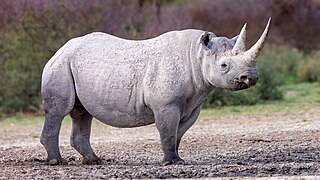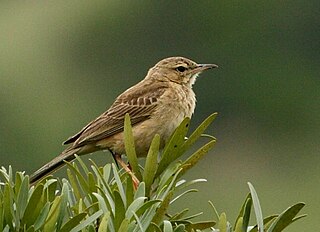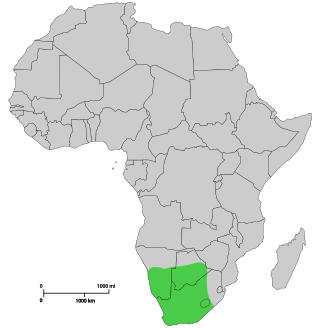Population and threats
Over the last 50 years, the south-central black rhinoceros population has declined by 90%. It was at 9,090 in 1980, but by 1995, due to a wave of illegal poaching for their horns, their numbers had decreased to 1,300. Their population then began to rebound somewhat. By 2001, it had increased to 1,651, and by 2010 it was about 2,200 (with 2,196 in Namibia, 1,684 of these in South Africa, 938 in Kenya, 431 in Zimbabwe, 212 in Tanzania, 58 in Zambia, 56 in Malawi, 48 in Eswatini, 28 in Rwanda, and 23 in Botswana. Only seven black rhinos remain in Chad and two remain in Mozambique). At present the number is increasing overall, but decreasing regionally (in Zimbabwe). The main threat to the subspecies is illegal poaching, which has increased in recent years. [1]

In Africa, the Big five game animals are the lion, leopard, rhinoceros, elephant, and African buffalo. The term was coined by big-game hunters to refer to the five most difficult animals in Africa to hunt on foot, but is now more widely used by game viewing tourists and safari tour operators. They are examples of charismatic megafauna, featuring prominently in popular culture, and are among the most famous of Africa's large animals.

The black rhinoceros, black rhino or hook-lipped rhinoceros is a species of rhinoceros, native to eastern and southern Africa including Angola, Botswana, Kenya, Malawi, Mozambique, Namibia, South Africa, Eswatini, Tanzania, Zambia, and Zimbabwe. Although the species is referred to as black, its colours vary from brown to grey. It is the only extant species of the genus Diceros.

A rhinoceros, commonly abbreviated to rhino, is a member of any of the five extant species of odd-toed ungulates in the family Rhinocerotidae; it can also refer to a member of any of the extinct species of the superfamily Rhinocerotoidea. Two of the extant species are native to Africa, and three to South and Southeast Asia.

The white rhinoceros, white rhino or square-lipped rhinoceros is the largest extant species of rhinoceros. It has a wide mouth used for grazing and is the most social of all rhino species. The white rhinoceros consists of two subspecies: the southern white rhinoceros, with an estimated 16,803 wild-living animals, and the much rarer northern white rhinoceros. The northern subspecies has very few remaining individuals, with only two confirmed left in 2018, both in captivity. Sudan, the world's last known male Northern white rhinoceros, died in Kenya on 19 March 2018 at age 45.

The eastern black rhinoceros, also known as the East African black rhinoceros, is a subspecies of the black rhinoceros. Its numbers are very low due to poaching for its horn, and it is listed as critically endangered.

The western black rhinoceros or West African black rhinoceros is an extinct subspecies of the black rhinoceros. It was declared extinct by the IUCN in 2011. The western black rhinoceros was believed to have been genetically different from other rhino subspecies. It was once widespread in the savanna of sub-Saharan Africa, but its numbers declined due to poaching. The western black rhinoceros resided primarily in Cameroon, but surveys since 2006 have failed to locate any individuals.

The south-western black rhinoceros is a subspecies of the black rhinoceros, living in southwestern Africa. It is currently listed as near threatened by the IUCN. The biggest threat towards the subspecies is illegal poaching.

The grey penduline tit, also known as the African penduline-tit, is a species of bird in the family Remizidae. It is found in Angola, Botswana, Burundi, Republic of the Congo, Democratic Republic of the Congo, Eswatini, Kenya, Malawi, Mozambique, Namibia, Rwanda, South Africa, Tanzania, Uganda, Zambia, and Zimbabwe. Its natural habitats are subtropical or tropical dry forests, dry savanna, and moist savanna. At 8 to 9 cm in length and a weight of 6.5 g (0.23 oz), it is one of the smallest species of bird found in Africa, along with its cousin the Cape penduline tit and the perhaps smaller mouse-colored penduline tit and the tit hylia.

The buffy pipit is a species of bird in the Motacillidae family. It is found in plains and open countryside in southern and eastern Africa. The IUCN has assessed its conservation status as being of least concern.

The rattling cisticola is a species of bird in the family Cisticolidae which is native to Africa south of the equator, and parts of East Africa. It is a common to abundant species in open savanna and scrubland habitats, whether in arid, moist or upland regions. Especially during summer, it is highly conspicuous due to its strident and repetitive call-notes from prominent perches.

The white-browed scrub robin, also known as the red-backed scrub-robin, is a species of bird in the family Muscicapidae. It is native to sub-Saharan Africa, especially East and southern Africa. Within range, its Turdus-like song is one of the often-heard sounds of the bush. The flitting of the tail is characteristic of this species, but also of some near relatives.

The rosy-throated longclaw, also known as the rosy-breasted longclaw is a species of bird in the family Motacillidae. It is found in Angola, Botswana, Democratic Republic of the Congo, Kenya, Malawi, Mozambique, Namibia, South Africa, Tanzania, Zambia, and Zimbabwe. Its natural habitat is subtropical or tropical seasonally wet or flooded lowland grassland.

The lesser honeyguide is a species of bird in the family Indicatoridae.

The Peters's epauletted fruit bat is a species of megabat in the family Pteropodidae. It is found in Angola, Botswana, Democratic Republic of the Congo, Eswatini, Malawi, Mozambique, Namibia, Tanzania, Zambia, and Zimbabwe. Its natural habitat is in riverine or evergreen forest, or moist woodland, where there are fruit-bearing trees.

The Angolan free-tailed bat is a species of bat in the family Molossidae. It is found in Angola, Benin, Botswana, Burkina Faso, Burundi, Cameroon, the Republic of the Congo, the Democratic Republic of the Congo, Ivory Coast, Eswatini, Ethiopia, Gambia, Ghana, Guinea, Kenya, Malawi, Mali, Mozambique, Namibia, Niger, Nigeria, Rwanda, Senegal, Sierra Leone, Somalia, South Africa, South Sudan, Sudan, Tanzania, Togo, Uganda, Zambia, and Zimbabwe. Its natural habitats are dry and moist savanna, although it is sometimes found at the edges of woodlands.

The southern black rhinoceros, southern hook-lipped rhinoceros or Cape rhinoceros is an extinct subspecies of the black rhinoceros that was once abundant in South Africa from the Cape Province to Transvaal, southern Namibia, and possibly also Lesotho and southern Botswana. Zoos, animal sanctuaries and conservation centers use this same scientific name as an indicating reference to the surviving south-central black rhinoceros. This former species was brought to extinction by excessive hunting and habitat destruction around 1850.
The Southern African Regional Universities Association was established in 2005 as a membership based association for the 66 public universities in the 15 countries of the Southern African Development Community (SADC).

The white-winged widowbird is a species of passerine bird in the family Ploceidae native to Africa south of the Sahara. It is highly sexually dimorphic in its breeding season, during which the male's yellow plumage turns dark and he gains more white feathers, contrasting with the female's predominantly pale coloration. Three subspecies are recognised.

The southern white rhinoceros or southern white rhino is one of the two subspecies of the white rhinoceros. It is the most common and widespread subspecies of rhinoceros.
The Zambezian region is a large biogeographical region in Africa. The Zambezian region includes woodlands, savannas, grasslands, and thickets, extending from east to west in a broad belt across the continent. The Zambezian region lies south of the rainforests of the Guineo-Congolian region. The Zambezian region is bounded by deserts and xeric shrublands on the southwest, the Highveld grasslands of South Africa to the south, and the subtropical Maputaland forests on the southeast.



















